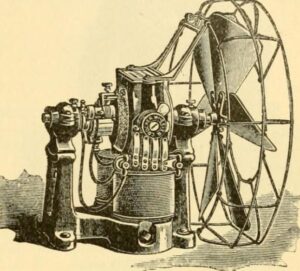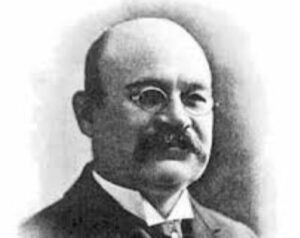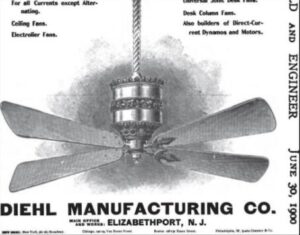That the ceiling fan has played the vital role of keeping homes in the hot and humid areas cooler and better habitable. It has also spared many residents of the risks of suffocation and other respiratory illnesses.
But just where did this marvelous piece of equipment originate? Who is generally credited with manufacturing it for the first time? And just what inspired him to produce this wonderful gadget?
We are going to answer these and indeed many more of these pertinent questions here below.

Who Invented The Ceiling Fan?
Now back to our main question. Who invented the ceiling fan?
Invention story
Philip Diehl, it was!
He was a German-American mechanical engineer who doubled up as a patent holder of many US patents.
These stretched from ceiling fans, sewing machines, electric motors, incandescent lamps, and electric lights, to name but a few.
He was born on January 29th, 1847, and lived through to April 7th, 1913. The fan itself has been invented earlier on, in 1882 by Schuyler Skaats Wheeler.
Philip Diehl improved this concept of the fan principally by attaching a fan blade to the sewing machine’s motor, after which he fixed it on the ceiling.
It is this modification that prompted him to apply for a patent thereafter. This patent was granted on November 12th, 1889.
Thereafter, he introduced a light fixture to the ceiling fan. Three years later, he attached a split-ball joint that enabled the unit to oscillate smoothly and hassle-free.
His invention did not go unnoticed. The item was picked up and commercially marketed by Crocker & Curtis Electric Motor Company.
This decision made the fan gain wider acceptability. It impacted households around the world in ways that have never been the same again. All these happened from 1882-1886.
Life of the inventor

Before the invention of the ceiling fan, Philip Diehl had a rough start in life. For one, he had lost all his possessions during the Great Fire of Chicago. That did not deter his resolve, though, as he chose to relocate to the other parts of the country that were more promising as it pertains to business matters.
This was Elizabeth, New Jersey, from where he took part in many experimental works that subsequently gave rise to the sewing machines.
Before that, he had worked in New York City, where he was attached to various apprenticeship tasks and purposes.
One such was the use of the dynamo to generate the currents for the arc lamps. After a successful try-out, he used the concept to power the incandescent lights, sewing machine motors, and many other electronic devices.
All these resulted in successful outcomes that gave him the impetus to scale greater heights.
To safeguard his inventions and innovations, he straight away applied for patents, which he received.
A judicial committee at the exhibition vouched for the said invention to the one if not the best dynamos that ever existed.
They simply operated way beyond the expectations and the impacts of the many alternatives that existed at that particular time.
He later credited these experiences for the expertise that eventually led him to design and produce the ceiling fan.
After a brief stint in New Jersey, he finally garnered launched his ceiling fan that has ultimately evolved into what we have today.
Advancement of ceiling fan

Several improvements have nonetheless been made to the unit to adapt to the challenges that be at the moment. Chief among these are the energy-saving and automated characters of the fans.
They jointly work to reduce the wastage of power and the hefty utility bills that ordinarily come along. The ceiling fan contains its motor unit that is self-contained and hence requires no belt drive.
When triggered, the motor rotates to have the fan sweep the air around it.
In the course of doing this, it distributes the cool air around the room while lowering the temperatures considerably.
His fans are now a radical improvement of what used to be in the days past. The extensive use of electrical energy to power the rotation is the most significant milestone in all these.
Given the easily controllable nature of the fans, they are less of a nuisance to operationalize.
Unlike many of his peers and like-minded inventors, he did not seek to make any capital from his inventions.
Instead, he let the same be duplicated by the various firms that are interested in furthering humanity’s welfare.
That is why we have gladly enjoyed the benefits of the ceiling fan today.

How Does a Ceiling Fan Work?
Before we answer this question, we have seen it necessary to briefly explain how the ceiling fan works.
As its name implies, the fan is mounted on the ceiling rather than on the floor or floor. This places it at a strategic advantage in the sense of imparting a more expansive area per unit time.
It comprises a motor that works to turn the blades. This motor, in turn, derives its motion power from the electricity via the power supply unit. It is triggered whenever the mains electricity switch is turned on.
Owing to its electrical power, the item does not falter. Still, it operates smoothly and consistently until such a time that it is turned on.
Conclusion
One thing reigns supreme from the previous explanations: that Philip Diehl was a determined and resilient person. He weathered many storms to rise to where he eventually finished off.
One wonders what might become of him had he continued to live for a relatively long duration of time thereafter.
It is only reasonably logical that would-be inventors and scientists draw inspiration from him. Have someone in your household who aspires to scale such heights in the future?
You have no choice but to administer this specific article to their consideration and subsequent use. Go for it now.
